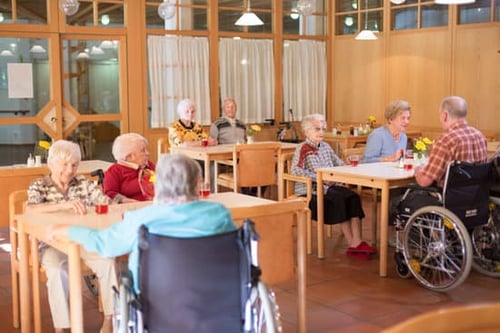

Defining “Senior Care” and the Elder Care Challenges Society Must Face
As America’s population continues to age, there are many challenges that senior care providers and policymakers will need to address in the coming years.
“As the Baby Boomer population ages, society is on the cusp of dealing with an unprecedented number of senior citizens who will need elder care,” writes Andrew Meola in Insider Intelligence.
Is America Really Ready for Its “Senior Moment”?
Basically, the United States is going to have an extended “senior moment” as the Population Reference Bureau (PRB) projects that the number of Americans ages 65 and older will nearly double from 52 million in 2018 to 95 million by 2060, and the 65-and-older age group’s share of the total population will rise from 16 percent to 23 percent.
“The current growth of the population ages 65 and older, driven by the large baby boom generation, is unprecedented in U.S. history. As they have passed through each major stage of life, baby boomers (between ages 55 and 73 in 2019) have brought both challenges and opportunities to the economy, infrastructure, and institutions,” says the PRB.
In turn, Meola writes that the United States home care market is expected to grow from $100 billion in 2016 to $225 billion by 2024, driven by the aging population.
“An intensifying shortage of US home health aides and physicians, a booming senior population, and the prevalence of chronic illnesses all point to a need for transformative solutions when it comes to senior care services,” writes Meola. “This will put considerable stress on Medicare and Medicaid, but the ramifications will ripple far beyond that.”
Defining “Seniors” and What Qualifies as “Senior Care”
It makes sense that there is no single definition of “senior care” because there actually is not a universal definition of what qualifies one to be a “senior”.
The age at which a person is considered a senior can vary depending on the source and context. Here are some common definitions:
- Social Security: The Social Security Administration defines full retirement age as between 66 and 67, depending on the year of birth. However, individuals can choose to start receiving retirement benefits as early as age 62, although the benefit amount will be reduced.
- Medicare: Medicare eligibility begins at age 65 for most people, regardless of whether they are retired or still working. Some people with disabilities may also be eligible for Medicare before age 65.
- AARP: AARP, a nonprofit organization focused on advocating for older Americans, considers people aged 50 and older to be "older Americans".
- World Health Organization: The World Health Organization defines "old age" as beginning at age 65, although this definition is somewhat arbitrary and may not reflect individual differences in health and well-being.
- United Nations: The United Nations considers people aged 60 and older to be "older persons" or "senior citizens."
Regardless of what age you consider one a senior, “senior care” refers to the support and assistance provided to elderly individuals who may require help with their daily activities, healthcare needs, or other aspects of their lives.
Senior care can be provided in various settings, including homes, assisted living facilities, nursing homes, and hospitals. Some examples of senior care services and programs include:
- In-home care: This involves aiding with daily activities such as bathing, dressing, meal preparation, and medication management in the person's own home.
- Assisted living: This is a housing option that provides a combination of housing, meals, healthcare, and personal care services to seniors who require some level of assistance with daily activities.
- Nursing homes: These are residential facilities that provide 24-hour medical care, supervision, and rehabilitation services for seniors with complex medical needs.
- Adult day care: This is a daytime program that provides social and recreational activities, meals, and sometimes medical care for seniors who need supervision and support during the day.
- Hospice care: This is specialized care for individuals who are terminally ill, focusing on symptom management and comfort care.
- Respite care: This is temporary care provided to seniors to give their primary caregivers a break from their caregiving duties.
- Memory care: This is specialized care for seniors with Alzheimer's disease or other forms of dementia, providing a safe and supportive environment and specialized services to help manage symptoms and maintain quality of life.
Senior Care Challenges as America’s Population Ages
With the oldest Baby Boomers beginning to turn 80 in 2025, the challenges for the future of senior care are becoming very real.
“It is easy to feel pessimistic — even apocalyptic — about the looming challenge of long-term care for the nearly 71 million baby boomers heading into their golden years,” reported CNBC. “When the oldest baby boomers begin turning 80 in 2025, there will be a growing wave of people who may need more support and services, and the burden will be heaviest for their children.”
Compounding this issue: the fact that the Baby Boom generation had fewer children than previous generations.
“Most long-term care is provided by a spouse, by children — daughters more often than sons — and by other family members,” reported CNBC. “With the baby boom generation having fewer children than their parents, there are fewer informal caregivers to shoulder the coming load. That suggests a growing need for more expensive formal care, either in-home or in an institutional setting.”
Challenges that senior care providers and policymakers must address include:
- Increased demand for care: With the baby boomer generation reaching retirement age, the number of seniors in need of care is expected to increase significantly, putting pressure on existing care providers, and creating a need for more services and facilities.
- Rising healthcare costs: As seniors tend to have more complex healthcare needs, the cost of providing care can be significant, particularly for those with chronic conditions or disabilities. This can make it difficult for some seniors to afford the care they need.
- Shortage of skilled caregivers: The demand for senior care services is already outpacing the supply of trained and experienced caregivers, and this gap is expected to widen in the coming years. This can make it challenging for seniors to access the care they need, particularly in rural or underserved areas.
- Caregiver burnout: Many seniors rely on family members or other informal caregivers for their day-to-day needs, and these caregivers can face significant stress and burnout as a result. This can affect the quality of care provided and can also lead to negative health outcomes for the caregiver.
- Lack of coordination and integration: Senior care is often delivered by a range of providers and organizations, including hospitals, primary care providers, and long-term care facilities. However, these providers may not always coordinate effectively with one another, leading to gaps in care and a lack of continuity.
- Aging infrastructure: Many of the facilities and homes where seniors receive care are aging and may not be well-suited to meet the needs of today's seniors. This can make it difficult to provide high-quality care in a safe and comfortable environment.
Addressing these challenges will require a multifaceted approach that includes increasing the supply of skilled caregivers, investing in new models of care, improving care coordination and integration, and addressing the underlying social and economic factors that can contribute to poor health outcomes for seniors.
Subscribe to email updates
Related Articles

Topics

Topics

Topics



